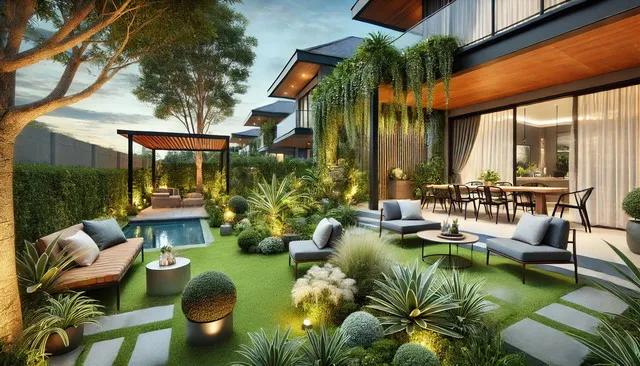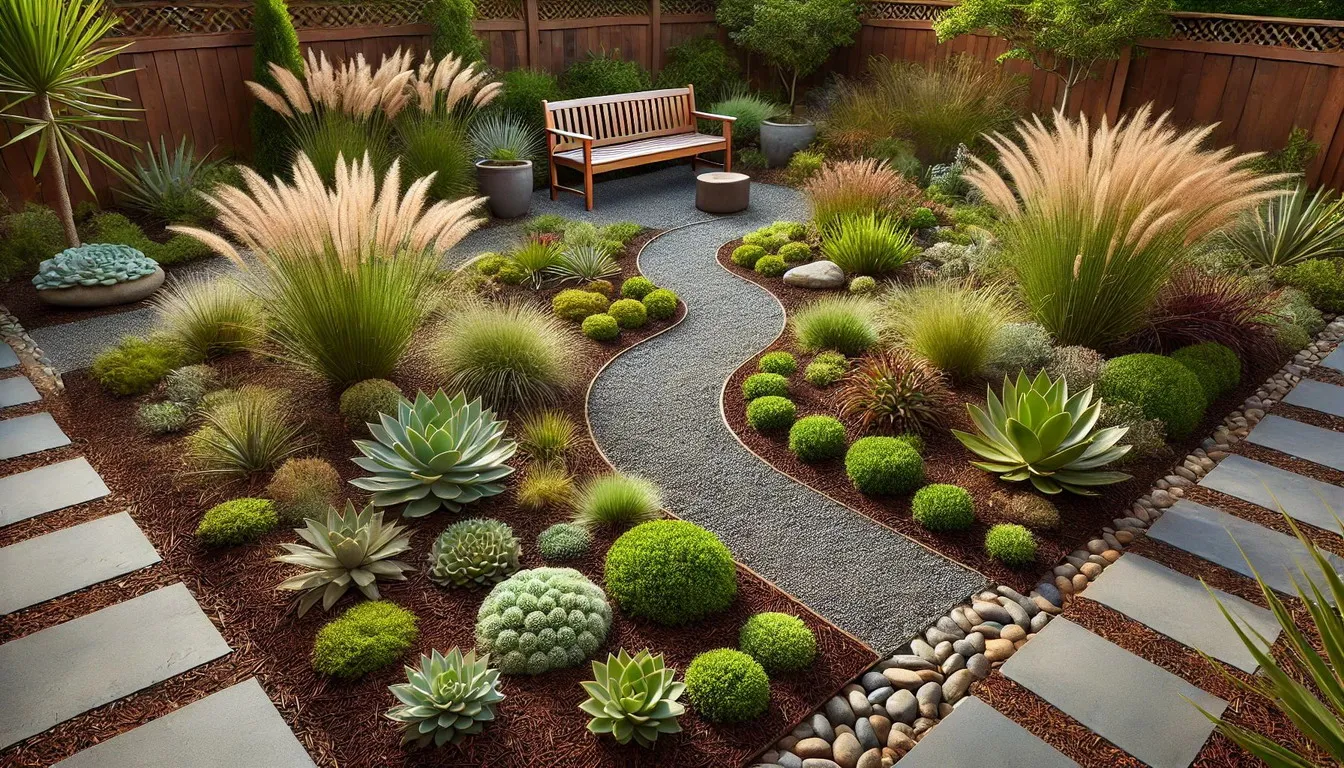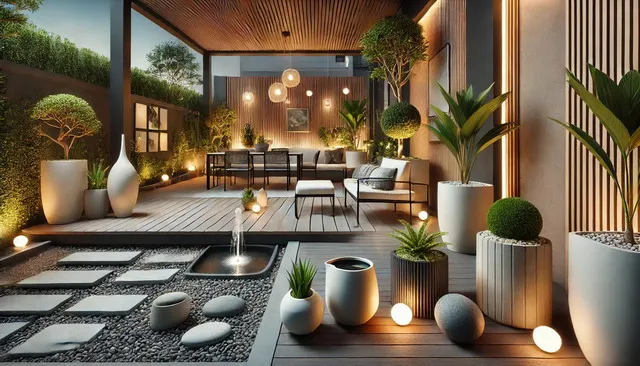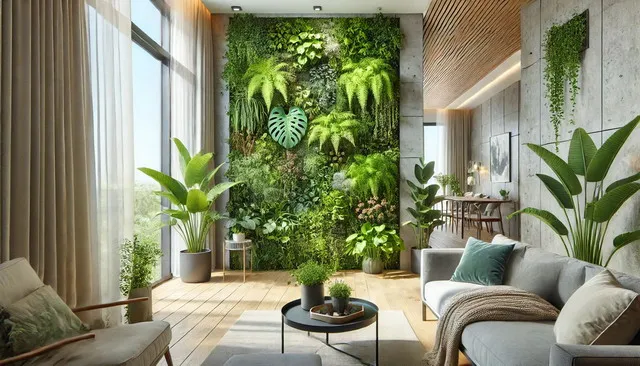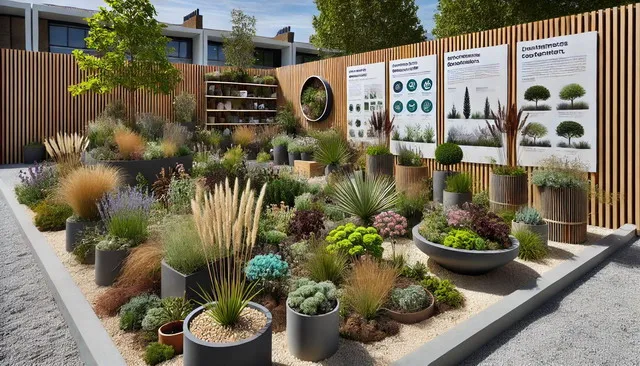Sustainable garden design trends 2026 are reshaping the way we approach landscaping, emphasizing the need for eco-friendly practices and innovative solutions to environmental challenges. As the effects of climate change become more apparent, the gardening community is increasingly prioritizing sustainability to create landscapes that are both beautiful and resilient. The trends for 2026 highlight the integration of smart technology, the use of renewable materials, and the adoption of practices that support biodiversity and water conservation.
These trends are not just about aesthetics; they reflect a deeper commitment to ecological balance and resource efficiency. From urban gardens that maximize limited space to rural landscapes that support local wildlife, sustainable garden design is transforming our outdoor spaces into havens of environmental stewardship. This article explores these emerging trends, providing insights and practical tips for gardeners looking to embrace sustainability in their gardening endeavors.
Innovative Sustainable Garden Design Trends 2026
The landscape of garden design is constantly evolving, with 2026 bringing a host of innovative sustainable trends. One notable trend is the integration of smart technology in garden management. Automated irrigation systems that use weather data to optimize water usage are becoming more prevalent. These systems not only conserve water but also ensure plants receive the right amount of hydration, reducing wastage and promoting healthier growth.
Another innovation is the use of renewable materials in garden construction. Recycled plastics, reclaimed wood, and natural stone are being used to create garden structures, pathways, and furniture. These materials not only reduce environmental impact but also add unique aesthetic elements to gardens. For example, pathways made from recycled glass can create stunning visual effects while being environmentally friendly.
Vertical gardening is also gaining popularity as a sustainable design trend. By utilizing vertical spaces, gardeners can maximize plant density in small areas, making it ideal for urban environments. Vertical gardens can be created using modular systems that allow for easy installation and maintenance. These systems often include integrated watering solutions that minimize water use while ensuring all plants are adequately hydrated. Vertical gardens provide insulation benefits and improve air quality by absorbing pollutants and releasing oxygen.
Furthermore, the incorporation of pollinator-friendly plants is a significant trend in 2026. Gardens are being designed to attract bees, butterflies, and other pollinators, which are crucial for ecosystem health. By creating habitats for these species, gardeners contribute to biodiversity and support food production. Specific plants, such as lavender, coneflower, and milkweed, are being increasingly used to create vibrant and beneficial pollinator gardens.
Another notable trend is the emphasis on edible landscaping. More gardeners are integrating fruits, vegetables, and herbs into their garden designs. This not only provides fresh, organic produce but also reduces the carbon footprint associated with food transportation. Raised beds and container gardening are popular methods to grow edibles in both large and small spaces.
Rainwater harvesting is another innovative practice gaining traction. Systems for collecting and storing rainwater for garden use are being integrated into garden designs. This not only conserves water but also provides a sustainable source of irrigation. Coupled with drought-resistant plant varieties, rainwater harvesting can significantly reduce the environmental impact of garden maintenance.
In addition, green roofs and living walls are becoming more common in sustainable garden design. These structures provide insulation, reduce urban heat islands, and create additional green spaces in urban areas. They also offer habitats for wildlife and contribute to improved air quality.
Overall, the innovative sustainable garden design trends of 2026 are focused on integrating technology, utilizing renewable materials, maximizing space, and supporting biodiversity. These trends are paving the way for gardens that are not only beautiful but also beneficial to the environment.
Eco-friendly Garden Design Practices for 2026
Eco-friendly garden design practices are essential for creating gardens that are not only beautiful but also sustainable. In 2026, these practices focus on minimizing resource consumption and promoting ecological balance.
One key practice is the use of native plants. Native plants are well-adapted to local climates and soil conditions, requiring less water and maintenance compared to non-native species. They also provide habitat and food for local wildlife, promoting biodiversity. By choosing native plants, gardeners can create resilient and self-sustaining landscapes.
Another important practice is water conservation. In 2026, efficient irrigation systems and drought-tolerant plant species are integral to sustainable garden design. Drip irrigation systems, for example, deliver water directly to the plant roots, reducing evaporation and runoff. Mulching is another technique used to retain soil moisture and suppress weeds, further conserving water.
Composting is a vital component of eco-friendly garden design. By recycling organic waste such as kitchen scraps and garden clippings, gardeners can create nutrient-rich compost that improves soil health and reduces the need for chemical fertilizers. Composting also helps sequester carbon, contributing to climate change mitigation.
Reducing chemical use is another critical aspect of eco-friendly gardening. Instead of synthetic pesticides and fertilizers, gardeners are turning to natural alternatives. Biological pest control, such as introducing beneficial insects like ladybugs and predatory mites, helps manage pest populations without harming the environment. Organic fertilizers, such as compost tea and fish emulsion, provide essential nutrients to plants without the adverse effects of synthetic chemicals.
Soil health is a cornerstone of sustainable garden design. Practices such as crop rotation, cover cropping, and reduced tillage help maintain soil structure and fertility. Cover crops, like clover and legumes, fix nitrogen in the soil and prevent erosion. These practices enhance soil biodiversity and create a healthy growing environment for plants.
Energy efficiency is also a focus in eco-friendly garden design. Solar-powered garden lights and water features reduce reliance on non-renewable energy sources. Additionally, choosing local materials for garden construction reduces the carbon footprint associated with transportation.
Incorporating wildlife habitats into garden design is another eco-friendly practice. Birdhouses, bat boxes, and insect hotels provide shelter for various species, supporting local ecosystems. Creating diverse plantings with different flowering times ensures a continuous food supply for pollinators and other beneficial insects throughout the growing season.
Permeable paving solutions are being used to manage stormwater runoff. Materials such as gravel, permeable concrete, and pavers allow water to infiltrate the soil, reducing flooding and recharging groundwater supplies. This practice is particularly important in urban areas where impervious surfaces dominate.
Lastly, community involvement and education play a crucial role in promoting eco-friendly garden practices. Community gardens, workshops, and educational programs help spread awareness about sustainable gardening techniques and encourage collective action towards environmental conservation.
By adopting these eco-friendly garden design practices, gardeners can create landscapes that are not only aesthetically pleasing but also environmentally responsible. These practices contribute to the overall health of the ecosystem and help mitigate the impacts of climate change.
2026 Sustainable Urban Garden Design Innovations
Urban gardening presents unique challenges and opportunities for sustainable design. In 2026, innovations in urban garden design are addressing these challenges and creating green oases in city environments.
One of the most significant innovations is the development of modular garden systems. These systems consist of pre-fabricated, lightweight modules that can be easily assembled and customized to fit various urban spaces. Modular gardens are ideal for rooftops, balconies, and small courtyards, providing flexibility and ease of installation.
Rooftop gardens are becoming increasingly popular in urban areas. These gardens utilize otherwise unused space and provide numerous benefits, including insulation, stormwater management, and habitat for wildlife. Advances in lightweight soil media and irrigation systems have made rooftop gardening more accessible and sustainable.
Community gardens are a vital component of urban sustainability. These shared spaces provide opportunities for urban residents to grow their own food, connect with nature, and build community ties. Innovative designs for community gardens include raised beds, vertical gardens, and hydroponic systems, which maximize productivity in limited spaces.
Hydroponic and aquaponic systems are revolutionizing urban agriculture. These soilless growing systems use nutrient-rich water to cultivate plants, making them ideal for indoor and rooftop gardens. Aquaponics combines hydroponics with aquaculture, using fish waste to provide nutrients for plants, creating a closed-loop system that is highly efficient and sustainable.
Green roofs and living walls are not only aesthetic additions to urban environments but also play a crucial role in sustainability. Green roofs reduce the urban heat island effect, improve air quality, and provide insulation for buildings. Living walls, or vertical gardens, can be installed on building facades to enhance insulation, reduce energy consumption, and create habitats for wildlife.
Smart garden technology is another innovation making urban gardening more sustainable. Sensors and automation systems monitor soil moisture, light levels, and temperature, optimizing plant care and reducing resource use. Smartphone apps allow gardeners to control irrigation, lighting, and other systems remotely, making urban gardening more convenient and efficient.
Urban beekeeping is gaining traction as cities recognize the importance of pollinators. Rooftop and balcony beehives provide habitat for bees, contributing to urban biodiversity and supporting food production. Educational programs and community initiatives are promoting urban beekeeping, ensuring that city environments remain pollinator-friendly.
Urban agriculture is also being integrated into public spaces. Parks, plazas, and even parking lots are being transformed into productive gardens that provide fresh produce for local communities. These initiatives not only address food security but also create green spaces that enhance urban livability.
Water management is a critical aspect of sustainable urban garden design. Rainwater harvesting systems collect and store rainwater for garden use, reducing dependence on municipal water supplies. Permeable paving and bioswales help manage stormwater runoff, preventing flooding and improving water quality.
Urban foraging is an emerging trend where edible plants are incorporated into public landscapes. Fruit trees, berry bushes, and herb gardens are planted in parks and along streets, providing residents with access to fresh, locally grown produce. This practice promotes food security and encourages people to engage with their local environment.
Innovations in lighting are making urban gardens more sustainable. LED grow lights are energy-efficient and can be used to extend growing seasons or support indoor gardening. Solar-powered garden lights reduce energy consumption and provide illumination for nighttime activities.
In summary, sustainable urban garden design innovations in 2026 are transforming city environments into green, productive spaces. These innovations address the unique challenges of urban gardening and provide solutions that are efficient, sustainable, and beneficial for both people and the environment.
Top Sustainable Garden Design Ideas for 2026
As sustainability becomes a central focus in garden design, new and creative ideas are emerging to create eco-friendly landscapes. In 2026, several sustainable garden design ideas are gaining popularity, combining aesthetics with environmental responsibility.
One of the top ideas is incorporating native plants into garden designs. Native plants are well-suited to local climates and require less water and maintenance. They also support local wildlife, including pollinators, birds, and beneficial insects. By choosing native plants, gardeners can create beautiful, low-maintenance gardens that promote biodiversity.
Edible landscaping is another sustainable garden design idea gaining traction. By integrating fruits, vegetables, and herbs into ornamental garden designs, gardeners can create attractive and productive landscapes. Raised beds, container gardens, and vertical planters are popular methods for growing edibles in both large and small spaces. This approach not only provides fresh, organic produce but also reduces the carbon footprint associated with food transportation.
Water conservation is a critical component of sustainable garden design. Xeriscaping, a landscaping method that uses drought-tolerant plants and efficient irrigation techniques, is becoming increasingly popular. Mulching is another technique used to retain soil moisture and suppress weeds. By choosing plants that thrive in local conditions and using water wisely, gardeners can create resilient landscapes that require less irrigation.
Pollinator gardens are an essential aspect of sustainable design. By planting a variety of flowers that bloom at different times, gardeners can provide a continuous food source for bees, butterflies, and other pollinators. Creating habitats for pollinators not only supports biodiversity but also enhances the beauty of the garden with colorful and fragrant flowers.
Rain gardens are designed to capture and filter rainwater, reducing runoff and improving water quality. These gardens are planted with native plants that can tolerate both wet and dry conditions. By directing rainwater into these gardens, homeowners can manage stormwater on their property and create attractive, functional landscapes.
Permeable paving solutions are also gaining popularity. Materials such as gravel, permeable concrete, and pavers allow water to infiltrate the soil, reducing flooding and recharging groundwater supplies. This practice is particularly important in urban areas where impervious surfaces dominate.
Composting is a vital practice for sustainable garden design. By recycling organic waste such as kitchen scraps and garden clippings, gardeners can create nutrient-rich compost that improves soil health and reduces the need for chemical fertilizers. Composting also helps sequester carbon, contributing to climate change mitigation.
Creating wildlife habitats within gardens is another sustainable design idea. Birdhouses, bat boxes, and insect hotels provide shelter for various species, supporting local ecosystems. Planting a mix of trees, shrubs, and flowers creates diverse habitats that attract a wide range of wildlife.
Energy efficiency is also a focus in sustainable garden design. Solar-powered garden lights and water features reduce reliance on non-renewable energy sources. Additionally, choosing local materials for garden construction reduces the carbon footprint associated with transportation.
Community involvement and education play a crucial role in promoting sustainable garden practices. Community gardens, workshops, and educational programs help spread awareness about sustainable gardening techniques and encourage collective action towards environmental conservation.
Green roofs and living walls are innovative ideas for creating additional green spaces in urban areas. These structures provide insulation, reduce urban heat islands, and create habitats for wildlife. They also offer aesthetic benefits and improve air quality by absorbing pollutants and releasing oxygen.
In summary, the top sustainable garden design ideas for 2026 focus on integrating native plants, conserving water, supporting pollinators, managing stormwater, composting, creating wildlife habitats, and promoting energy efficiency. These ideas not only enhance the beauty and functionality of gardens but also contribute to environmental conservation and sustainability.
Future of Sustainable Garden Landscaping in 2026
The future of sustainable garden landscaping is set to be shaped by emerging trends and technologies that focus on environmental conservation and resource efficiency. In 2026, several key trends are expected to redefine garden landscaping, making it more sustainable and resilient.
One of the most significant trends is the integration of smart technology in garden management. Automated irrigation systems, soil sensors, and weather monitoring devices are becoming more sophisticated, allowing gardeners to optimize water use and plant care. These technologies help reduce water waste, improve plant health, and make garden maintenance more efficient.
Renewable energy sources are playing a crucial role in sustainable landscaping. Solar-powered lights, water features, and garden tools are becoming more common, reducing reliance on non-renewable energy sources. These innovations not only save energy but also reduce greenhouse gas emissions, contributing to a more sustainable future.
Biodiversity is a key focus in future garden landscaping. Garden designs are incorporating a wider variety of plants to create diverse ecosystems that support wildlife. Native plants, pollinator gardens, and wildlife habitats are becoming integral parts of garden landscapes. By promoting biodiversity, gardeners can create resilient ecosystems that are better equipped to adapt to changing environmental conditions.
Climate change resilience is another important aspect of future landscaping. Garden designs are being adapted to withstand extreme weather conditions, such as droughts, floods, and heatwaves. Drought-tolerant plants, rain gardens, and permeable paving solutions are being used to create landscapes that can cope with these challenges. These adaptations help ensure that gardens remain functional and attractive even in the face of climate change.
Sustainable materials are becoming more prevalent in garden construction. Recycled and locally sourced materials are being used to create garden structures, pathways, and furniture. These materials reduce the environmental impact of garden construction and add unique aesthetic elements to landscapes. For example, reclaimed wood can be used to build garden beds, while recycled glass can be used for decorative pathways.
Water conservation is a critical focus for future garden landscaping. Efficient irrigation systems, such as drip irrigation and rainwater harvesting, are being widely adopted. These systems help reduce water use and ensure that plants receive the right amount of hydration. Mulching and soil improvement techniques are also being used to retain soil moisture and reduce the need for frequent watering.
Edible landscaping is set to become a significant trend in 2026. More gardeners are integrating fruits, vegetables, and herbs into their landscapes, creating attractive and productive gardens. This trend not only provides fresh, organic produce but also promotes food security and reduces the carbon footprint associated with food transportation. Raised beds, vertical gardens, and container gardening are popular methods for growing edibles in various garden spaces.
Community involvement and education are essential for the future of sustainable landscaping. Community gardens, educational programs, and workshops help spread awareness about sustainable practices and encourage collective action. These initiatives foster a sense of community and promote environmental stewardship.
Green infrastructure is another important aspect of future garden landscaping. Green roofs, living walls, and urban forests are being integrated into cityscapes to provide environmental benefits. These green spaces help reduce urban heat islands, improve air quality, and provide habitats for wildlife. They also offer aesthetic and recreational benefits for urban residents.
Innovations in lighting are making garden landscapes more sustainable. LED grow lights and solar-powered garden lights are energy-efficient options that reduce energy consumption. These lighting solutions are being used to extend growing seasons, support indoor gardening, and illuminate garden spaces at night.
In conclusion, the future of sustainable garden landscaping in 2026 is set to be shaped by smart technology, renewable energy, biodiversity, climate resilience, sustainable materials, water conservation, edible landscaping, community involvement, green infrastructure, and innovative lighting. These trends and technologies are paving the way for garden landscapes that are not only beautiful and functional but also environmentally responsible and resilient.
Sustainable Gardening Techniques and Trends for 2026
Sustainable gardening techniques are essential for creating gardens that are not only beautiful but also environmentally responsible. In 2026, several sustainable gardening techniques and trends are emerging, focusing on resource conservation, biodiversity, and ecological balance.
One of the most important sustainable gardening techniques is the use of native plants. Native plants are well-adapted to local climates and soil conditions, requiring less water and maintenance compared to non-native species. They also provide habitat and food for local wildlife, promoting biodiversity. By choosing native plants, gardeners can create resilient and self-sustaining landscapes.
Water conservation is a critical aspect of sustainable gardening. Efficient irrigation systems, such as drip irrigation and soaker hoses, deliver water directly to the plant roots, reducing evaporation and runoff. Mulching is another technique used to retain soil moisture and suppress weeds, further conserving water. Rainwater harvesting systems collect and store rainwater for garden use, reducing dependence on municipal water supplies.
Composting is a vital component of sustainable gardening. By recycling organic waste such as kitchen scraps and garden clippings, gardeners can create nutrient-rich compost that improves soil health and reduces the need for chemical fertilizers. Composting also helps sequester carbon, contributing to climate change mitigation. Vermicomposting, which uses worms to break down organic matter, is another effective method for producing high-quality compost.
Reducing chemical use is another critical aspect of sustainable gardening. Instead of synthetic pesticides and fertilizers, gardeners are turning to natural alternatives. Biological pest control, such as introducing beneficial insects like ladybugs and predatory mites, helps manage pest populations without harming the environment. Organic fertilizers, such as compost tea and fish emulsion, provide essential nutrients to plants without the adverse effects of synthetic chemicals.
Soil health is a cornerstone of sustainable gardening. Practices such as crop rotation, cover cropping, and reduced tillage help maintain soil structure and fertility. Cover crops, like clover and legumes, fix nitrogen in the soil and prevent erosion. These practices enhance soil biodiversity and create a healthy growing environment for plants.
Energy efficiency is also a focus in sustainable gardening. Solar-powered garden lights and water features reduce reliance on non-renewable energy sources. Additionally, choosing local materials for garden construction reduces the carbon footprint associated with transportation.
Incorporating wildlife habitats into garden design is another sustainable practice. Birdhouses, bat boxes, and insect hotels provide shelter for various species, supporting local ecosystems. Creating diverse plantings with different flowering times ensures a continuous food supply for pollinators and other beneficial insects throughout the growing season.
Permaculture is an emerging trend in sustainable gardening. This holistic approach to gardening emphasizes the creation of self-sustaining ecosystems that mimic natural processes. Permaculture principles include designing gardens with multiple layers of vegetation, using companion planting to enhance plant growth, and incorporating elements such as ponds and swales to manage water resources.
Urban gardening is also becoming more sustainable. Innovations such as vertical gardens, rooftop gardens, and hydroponic systems are making it possible to grow plants in small urban spaces. These techniques maximize plant density and productivity while minimizing resource use. Community gardens and urban farms are also promoting sustainable gardening practices and providing fresh, locally grown produce to city residents.
Biodynamic gardening is another trend gaining popularity. This approach to gardening treats the garden as a holistic, self-sustaining ecosystem. Biodynamic practices include using compost and manure preparations, following lunar planting calendars, and promoting biodiversity. These techniques enhance soil fertility, improve plant health, and create balanced ecosystems.
Finally, sustainable gardening education and community involvement are crucial for promoting sustainable practices. Workshops, gardening clubs, and online resources provide valuable information and support for gardeners. Community gardens and educational programs help spread awareness about sustainable techniques and encourage collective action towards environmental conservation.
In summary, sustainable gardening techniques and trends for 2026 focus on native plants, water conservation, composting, reducing chemical use, soil health, energy efficiency, wildlife habitats, permaculture, urban gardening, biodynamic gardening, and education. These practices contribute to the overall health of the ecosystem and help mitigate the impacts of climate change, creating gardens that are both beautiful and environmentally responsible.
Conclusion
Sustainable garden design trends 2026 are more than just a fleeting interest—they represent a fundamental shift towards environmentally responsible gardening practices. As we move forward, the integration of smart technology, the use of native plants, and innovative water conservation techniques will play crucial roles in shaping our gardens. These practices not only enhance the beauty of our outdoor spaces but also contribute significantly to ecological health and resilience.
By adopting these sustainable trends, gardeners can create vibrant, functional landscapes that benefit both people and the planet. The future of gardening lies in our ability to harmonize with nature, and the trends of 2026 offer a roadmap to achieving this goal. Embracing sustainable garden design is not just an option; it is an imperative step towards ensuring a healthier and more sustainable future for generations to come.
